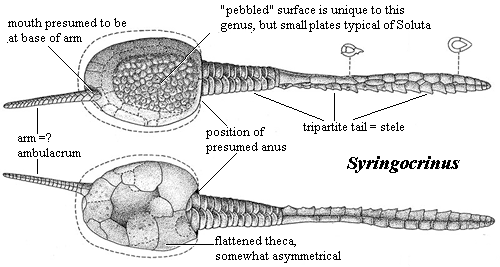
| Palaeos |  |
Homalozoa |
| Deuterostomia | Soluta |
| Page Back | Unit Back | Metazoa | Metazoa References | Metazoa Dendrogram | Pieces | Taxon Index |
| Page Next | Unit Next | Unit Home | Unit References | Unit Dendrogram | Glossary | Time |
Homalozoa |--Stylophora `--+--Soluta `--+--Cincta `--+--Ctenocystoidea `--+--Helicoplacoidea `--ECHINODERMATA |
|
 Like
Stylophora, the Soluta appear to have never been
overly diverse but occur over a long stratigraphic range, from the Middle
Cambrian to the Lower
Devonian. Caster
(1967); Parsley (1997). Also
like Stylophora, the main body of Soluta is an asymmetrical flattened
theca. However in Soluta the theca possesses two appendages at roughly
opposite ends, one significantly larger than the other. Almost all
researchers agree that the smaller appendage is anterior and represents a
feeding arm, while the larger appendage (the "stele") probably
functioned as a propulsive tail.
Like
Stylophora, the Soluta appear to have never been
overly diverse but occur over a long stratigraphic range, from the Middle
Cambrian to the Lower
Devonian. Caster
(1967); Parsley (1997). Also
like Stylophora, the main body of Soluta is an asymmetrical flattened
theca. However in Soluta the theca possesses two appendages at roughly
opposite ends, one significantly larger than the other. Almost all
researchers agree that the smaller appendage is anterior and represents a
feeding arm, while the larger appendage (the "stele") probably
functioned as a propulsive tail.
 The
arm is generally clearly divided from the theca. It is contained by four rows of
plates with the plates smaller along the dorsal side, probably indicating an
ambulacrum. The exact location of the mouth is unknown, but is undoubtedly
near the base of the arm. The anus was near the posterior ?right of the
theca. Another opening near the arm is interpreted as the hydropore.
The
arm is generally clearly divided from the theca. It is contained by four rows of
plates with the plates smaller along the dorsal side, probably indicating an
ambulacrum. The exact location of the mouth is unknown, but is undoubtedly
near the base of the arm. The anus was near the posterior ?right of the
theca. Another opening near the arm is interpreted as the hydropore.
The stele is divided into three parts, the tetramerous proxistele closest to the theca tapering through the mesistele to the dimerous dististele furtherest from the theca. In the reconstruction used here, the stele is homologous with the stylophoran tail, as suggested by its position and tripartite division. The possession of an ambualcrum suggests a more crownward position than Stylophora.
Needless to say, other reconstructions would indicate other positions. If the
stylophoran appendage is interpreted as an aulacophore, it may correspond to the
solute arm rather than the stele. Caster (1967) regarded the Stylophora
and Soluta as independently derived from pentaradial ancestors with the solute
arm and stele both representing derived arms. Under the
"calcichordate" hypothesis, some solutes were stem
"Dexiothetica" while others were stem chordates
less crownward than Stylophora.  Jefferies (1997). This theory also
differs in reversing the suggesting orientation so that the ambulacral side of
the arm is ventral.
Jefferies (1997). This theory also
differs in reversing the suggesting orientation so that the ambulacral side of
the arm is ventral.
In the earliest solute genera, Coleicarpus and Castericystis, the distal end of the stele bears a holdfast, though in juveniles only in Castericystis. All other solutes were free-living. They probably lay flat on the sediment, living as passive filter feeders. Later species show a tendency to reduce the size of the arm and develop a more bilaterally symmetrical theca.
© Christopher Taylor CT050908.
Images: Dendrocystoides and starfish from The Passionate Collector - George Rae Fossils: An exhibition of fossils collected by George Rae and bequeathed to the Hunterian Museum. Syringocrinus adapted from two figures at Geologic Overview of the Trenton Group by the Harvard Museum of Comparative Zoology.
| Page Back | Page Top | Unit Home | Page Next |